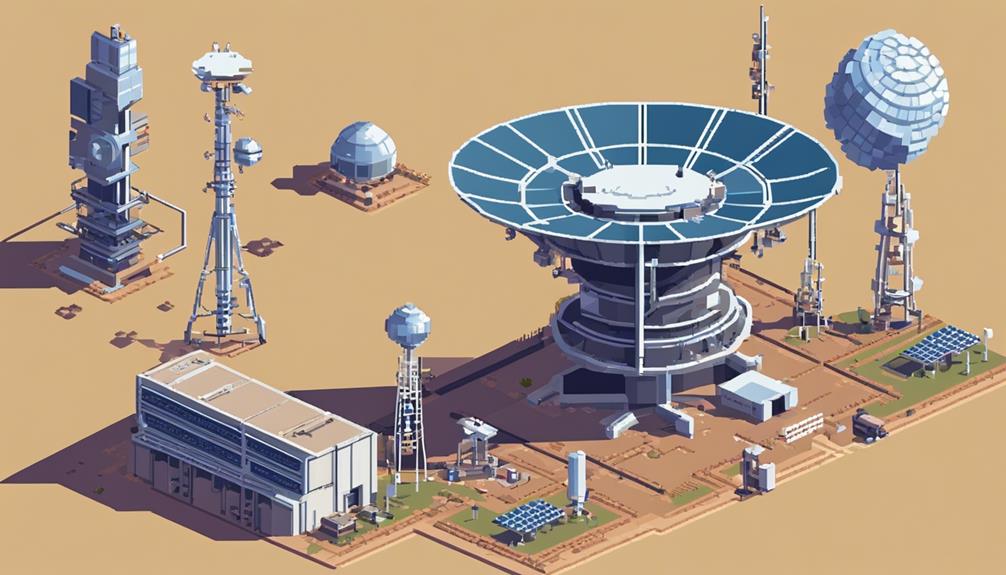Satellite ground stations serve as the vital link between satellites orbiting in space and Earth-based systems, ensuring the uninterrupted flow of data essential for various industries and services. These stations, equipped with sophisticated technology like antennas, receivers, and security systems, are crucial for maintaining satellite communication networks' efficiency and reliability. Understanding the intricate workings of satellite ground stations unveils a world where advanced technology meets the demands of global connectivity, but beyond the surface lies a realm of challenges, innovations, and future developments that shape the landscape of satellite communication.
Key Takeaways
- Ground stations are vital for tracking orbits and managing data reception efficiently.
- They ensure global communication coverage and support industries like telecommunications and weather forecasting.
- Ground stations play a crucial role in maintaining operational parameters and ensuring reliable communication links.
- Advanced technology and infrastructure in ground stations drive advancements to meet evolving demands in the satellite industry.
What Are Satellite Ground Stations?

Satellite ground stations are essential terrestrial facilities that establish communication with satellites through the transmission and reception of radio waves. These stations are pivotal in tracking the orbits of satellites, ensuring seamless communication by transmitting commands, and receiving data efficiently. The tracking aspect involves monitoring the satellites' positions, velocities, and timing to establish and maintain communication links accurately.
Transmitting and receiving data are core functions of ground stations. Transmitters within these stations send commands to satellites, enabling operations such as adjusting orbits, activating specific functions, or downloading data. On the other hand, receivers capture the signals sent by satellites, extracting valuable information such as images, sensor readings, or communications data. The ability to transmit commands and receive data effectively is crucial for various industries utilizing satellite services, including telecommunications, weather forecasting, and emergency communication services.
Ground stations are equipped with advanced technology to enhance their tracking, transmitting, and receiving capabilities. These facilities often feature high-gain antennas for precise communication, sophisticated receivers for signal processing, and powerful transmitters for reliable data transmission. By optimizing these components, ground stations contribute significantly to improving data transfer speeds and ensuring reliable satellite operations, ultimately facilitating global connectivity in today's interconnected world.
Understanding Ground Station Components
An essential element of satellite ground stations is the intricate network of components that work together to ensure seamless communication with satellites. These components include reception antennas, feed horns, waveguides, receivers, and radomes for protection. The antenna, also known as the primary component, plays a crucial role in satellite ground stations by directing and reflecting radio waves, amplifying incoming signals, and collecting reflected signals through a feed horn.
Within ground stations, electromagnetic waves are converted into electrical currents for amplification and the retrieval of the original source signals. Different types of satellites, such as those in geostationary orbit or low Earth orbit, necessitate varying ground station components for effective communication. Systems like Oberon, Capella, and Telesto employ diverse antenna configurations tailored for applications in meteorology, oceanography, and satellite communication.
For satellites in geostationary orbit, ground station components need to be precisely designed to establish and maintain constant communication due to the satellite's fixed position relative to the Earth. Understanding the functionality and integration of these components is essential for ensuring reliable and efficient communication between ground stations and satellites in orbit.
Role of Ground Stations in Communication

Ground stations serve as critical hubs for facilitating seamless communication with satellites by tracking orbits, sending commands, and receiving data, playing a pivotal role in supporting various industries such as telecommunications, weather forecasting, and navigation. These stations are essential for enabling global communication coverage and emergency communication services. The role of ground stations in communication is indispensable for ensuring reliable satellite operations and enhancing data transfer speeds.
Key Points:
- Global Coverage: Ground stations enable communication with satellites across the globe, ensuring that signals are transmitted and received efficiently worldwide.
- Radio Waves: Ground stations utilize radio waves to establish communication links with satellites, allowing for the transmission of commands and data.
- Industry Support: Ground stations play a crucial role in supporting industries like telecommunications, weather forecasting, and navigation by providing the necessary communication infrastructure for satellite operations.
Key Functions of Ground Stations
Ground stations serve crucial functions in the satellite communication ecosystem by managing data reception methods and signal transmission processes. These stations act as pivotal interfaces between satellites and ground networks, ensuring seamless data exchange and communication. Understanding the intricacies of data reception and signal transmission is fundamental to grasping the essential role of ground stations in satellite operations.
Data Reception Methods
Efficiently capturing signals from satellites and processing them for transmission is a fundamental function of ground stations in data reception methods. Ground stations achieve this through specific processes:
- Antenna Reception: Ground stations receive data from satellites using antennas equipped with receivers, ensuring the signals are captured effectively.
- Tracking System Utilization: Ground stations employ tracking systems to maintain alignment with moving satellites. This ensures continuous data reception despite the satellites' orbital movements.
- Data Processing for Utilization: The received data plays a critical role in monitoring satellite health, extracting valuable information, and troubleshooting communication issues. Ground stations process this data efficiently for various applications, ensuring seamless communication between satellites and terrestrial networks.
Signal Transmission Processes
In the realm of satellite ground stations, the seamless transmission of signals to and from satellites stands as a core function vital for commanding operations and facilitating data exchanges. Ground stations utilize parabolic antennas to receive signals from satellites, enabling the monitoring of satellite health and performance. These stations are responsible for tracking satellite positions and velocities, ensuring efficient communication by establishing and maintaining connectivity with satellites across various industries. Signal transmission processes at ground stations are meticulously designed to guarantee uninterrupted and reliable communication with satellites, playing a crucial role in the overall functionality and success of satellite operations. The use of advanced technologies and precise signal transmission techniques is imperative for the effective operation of ground stations in the satellite communication ecosystem.
Significance of Ground Stations

Playing a pivotal role in satellite operations, ground stations are instrumental in overseeing satellite orbits, data transmission, and system health monitoring for various critical industries. Ground stations are crucial components in the network of satellite communication infrastructure, providing essential support for global communications. Here are three key reasons highlighting the significance of ground stations:
- Orbit Tracking and Command Transmission: Ground stations track the precise location and movement of satellites in orbit. By sending commands to adjust their positions or functions, ground stations ensure that satellites maintain their designated orbits and operational parameters. This capability is vital for maintaining reliable communication links and optimizing satellite performance.
- Data Reception and Monitoring: Ground stations receive data transmitted by satellites, including images, weather patterns, and communication signals. They play a critical role in processing, analyzing, and distributing this data to end-users, such as weather forecasters, telecommunication companies, and emergency response teams. Monitoring satellite health and performance parameters is also essential to detect any anomalies and ensure continuous operation.
- Global Communication Coverage: Ground stations facilitate global communication coverage by establishing communication links with satellites orbiting the Earth. This enables seamless connectivity and communication services worldwide, supporting various industries that rely on satellite communication for essential operations, including telecommunication networks, weather monitoring systems, and emergency communication services.
Operational Mechanisms of Ground Stations
Ground stations operational mechanisms encompass a sophisticated array of telemetry tracking, command transmission, data reception, real-time monitoring, and issue troubleshooting to ensure the seamless functioning of satellite networks. The primary function of ground stations is satellite tracking, where they utilize telemetry data to monitor the orbits of satellites accurately. By tracking the satellites' positions and movements, ground stations can send necessary commands for operational adjustments, such as repositioning or configuration changes, to optimize satellite performance.
Moreover, ground stations play a crucial role in receiving data transmitted by satellites. This data is essential for various purposes, including processing, analysis, and distribution to end-users. Real-time monitoring is another critical aspect of ground station operations. Ground stations continuously monitor various parameters related to satellite health and performance to detect any anomalies promptly.
In addition to monitoring, ground stations are equipped to troubleshoot communication issues that may arise during satellite operations. Efficient issue troubleshooting is vital for maintaining uninterrupted satellite communication and ensuring the overall reliability of the satellite network. Overall, the operational mechanisms of ground stations are integral to the successful functioning of satellite networks and the seamless delivery of satellite services.
Ground Station Infrastructure Overview

The infrastructure of satellite ground stations encompasses critical components such as equipment and antennas, data processing systems, and communication protocols. These elements work together to facilitate the reception, transmission, and processing of satellite data efficiently. By optimizing these aspects of the ground station infrastructure, reliable satellite operations and robust data transfer speeds can be achieved.
Equipment and Antennas
Antenna systems form the backbone of ground station infrastructure, serving as essential components for receiving and processing satellite signals. Ground station equipment includes various components like reception antennas, feed horns, waveguides, receivers, and radomes designed to protect these systems. Antennas in ground stations play a crucial role in directing and reflecting radio waves, amplifying signals, and collecting reflected signals with feed horns. They are instrumental in converting electromagnetic waves into electrical currents for further signal processing. Different satellite types, such as geostationary and low Earth orbit, necessitate specific ground station antenna designs to ensure optimal performance. Ground station systems like Oberon, Capella, and Telesto employ a range of antenna sizes and designs tailored for applications in fields like meteorology and oceanography.
Data Processing Systems
Utilizing cutting-edge technology and sophisticated hardware, data processing systems within satellite ground stations are pivotal components responsible for managing the reception, storage, and analysis of satellite data. These systems employ high-performance computers, storage units, and networking equipment to handle large volumes of data efficiently. Ground station data processing systems ensure data integrity, accuracy, and timely delivery to end users. Advanced algorithms and software are utilized to analyze, interpret, and distribute satellite data effectively, transforming raw data into actionable information for various applications. Additionally, these systems can incorporate global positioning systems (GPS) for precise location data and weather data for meteorological analysis. The table below outlines key aspects of data processing systems in satellite ground stations.
| Aspect | Description |
|---|---|
| Equipment Used | High-performance computers, storage units, networking equipment |
| Functionality | Reception, storage, analysis of satellite data |
| Key Features | Data integrity, accuracy, timely delivery |
Communication Protocols
Ground station infrastructure relies on robust communication protocols such as TCP/IP, UDP, and SNMP to facilitate efficient data exchange and management between ground stations and satellites.
Key Points:
- TCP/IP: Ensures reliable data transmission between Earth stations and satellites.
- UDP: Preferred for real-time applications due to lower latency in data transmission.
- SNMP: Used for monitoring and managing network devices in ground station operations.
Implementing these communication protocols is crucial for seamless and secure data exchange in satellite ground station infrastructure. They enable the transmission of commands to satellites and the reception of data, ensuring effective communication in global positioning systems (GPS) operations.
Ground Stations in Global Communication Network

An integral component of the global communication network, ground stations serve as vital terrestrial radio communication facilities facilitating seamless data exchange with satellites. These earth stations are strategically positioned to establish a critical link between satellite systems orbiting in space and terrestrial telecommunication networks on the ground. Ground stations are designed to track the positions and velocities of satellites with precision, enabling efficient communication protocols.
Ground stations play a pivotal role in commanding satellites by sending instructions for various functions such as orbit adjustments, data collection, and payload operations. Simultaneously, they receive data transmitted by satellites, including images, weather information, and other telemetry data essential for a wide array of applications across industries. Without the presence of ground stations, the functionality and effectiveness of satellite-based communications would be severely compromised.
These stations act as gateways for satellite signals, ensuring that the data is accurately transmitted and received, contributing to the seamless connectivity required by industries such as telecommunications, meteorology, navigation, and remote sensing. The intricate network of ground stations worldwide forms the backbone of satellite communication systems, enabling real-time data exchange and enhancing global connectivity.
Ground Station Connectivity and Data Transfer
Facilitating seamless data exchange between satellites and terrestrial networks, ground stations play a crucial role in ensuring efficient connectivity and reliable data transfer. Ground stations serve as the linchpin in the communication chain between satellites in orbit and users on the ground, handling vast amounts of data with precision and speed. Here are three key aspects related to ground station connectivity and data transfer:
- High-Speed Data Transfer: Ground stations are equipped with advanced technology to support high-speed data transfer between satellites and terrestrial networks. This capability is essential for various applications such as telecommunications, weather forecasting, and remote sensing, where real-time data transmission is critical.
- Seamless Connectivity: Ground stations ensure seamless connectivity by establishing and maintaining communication links with satellites orbiting the Earth. These stations are strategically located to provide comprehensive coverage, enabling continuous data exchange and uninterrupted communication services.
- Reliable Data Transfer: Ground stations play a critical role in transferring large volumes of data reliably and efficiently. Through precise operational procedures and constant monitoring, data transfer rates are optimized to guarantee the secure and timely delivery of information between satellites and terrestrial systems.
The connectivity and data transfer capabilities of ground stations are fundamental to the functioning of satellite communication networks, supporting a wide range of essential services and applications.
Ground Station Management and Control

Ground station management and control encompass critical tasks such as monitoring station systems, enabling remote access capabilities, and maintaining equipment procedures. These functions are essential for ensuring seamless communication with satellites, optimizing performance, and addressing any operational issues efficiently. Ground station operators rely on specialized tools and automated systems to uphold the reliability and effectiveness of satellite operations across various industries.
Station Monitoring Systems
Efficient management of ground station monitoring systems is essential for ensuring the seamless operation of satellite communications. Ground station monitoring systems play a crucial role in overseeing various aspects such as satellite health, performance, and communication links. To achieve optimal functionality, these systems track satellite orbits, manage data reception and transmission, and ensure operational efficiency. Ground station management includes real-time monitoring, command execution, and troubleshooting capabilities, allowing operators to adjust satellite parameters and maintain optimal communication. Control systems at ground stations enable operators to make necessary adjustments promptly, ensuring continuous and reliable communication with satellites.
- Satellite health, performance, and communication links oversight.
- Real-time monitoring, command execution, and troubleshooting capabilities.
- Control systems for adjusting satellite parameters and maintaining optimal communication.
Remote Access Capabilities
Remote access capabilities in ground station management and control systems enable operators to efficiently monitor and control satellite systems from a centralized location. Through advanced technology, operators can remotely adjust antenna positioning, manage communication protocols, and troubleshoot issues in real-time. Utilizing secure remote access protocols ensures data integrity and confidentiality during satellite operations. Additionally, ground station management systems offer tools for scheduling, logging, and analyzing satellite communication activities. The integration of global positioning systems (GPS) further enhances the accuracy and effectiveness of remote access capabilities. Overall, these features streamline operations, reduce downtime, and improve efficiency in satellite ground station management, demonstrating the benefits of remote access in modern satellite systems.
Equipment Maintenance Procedures
To ensure the optimal performance and reliability of satellite ground station systems, meticulous equipment maintenance procedures encompass regular inspections, testing, calibration, and upkeep of critical components such as antennas, receivers, transmitters, and computer systems.
- Regular inspections, testing, and calibration of antennas, receivers, transmitters, and computer systems.
- Scheduled maintenance activities ensure optimal performance and reliability of ground station components.
- Cleaning, lubricating moving parts, checking power supplies, and updating software for efficient operations.
Ground Station Tracking and Monitoring

Ground stations play a critical role in effectively tracking and monitoring satellites' orbits to ensure optimal communication alignment. Monitoring satellite health and performance is a key function of ground stations, as they track the orbits of satellites in real-time to guarantee proper positioning for communication purposes. Ground stations are equipped with specialized tools and software that enable operators to monitor the status of satellites continuously. These stations also send commands to satellites for operational adjustments based on the monitoring data.
One of the essential tasks performed by ground station operators is troubleshooting communication issues. They actively work to identify and resolve any disruptions in the communication link between the satellite and the ground station promptly. Additionally, ground stations meticulously monitor the data received from satellites for accuracy and reliability. This monitoring process ensures that the information transmitted by the satellite is correctly captured and interpreted.
Challenges in Ground Station Operations
Challenges in the efficient operation of ground stations arise from various factors, including signal interference, weather conditions, electromagnetic disruptions, security risks, and limitations in satellite visibility. These challenges can significantly impact the reliability and effectiveness of ground station operations. Here are three key challenges faced by ground station operators:
- Signal Interference: Ground stations often encounter signal interference from terrestrial sources such as radio frequency interference (RFI) or electromagnetic interference (EMI) from nearby electronic devices. These interferences can degrade the quality of communication with satellites and affect data transmission.
- Weather Conditions: Adverse weather conditions like heavy rain, storms, or atmospheric disturbances can impede the smooth functioning of ground stations. Rain attenuation, for example, can weaken or disrupt the signals between the ground station and the satellite, leading to communication errors or signal loss.
- Security Risks: Ground station facilities are vulnerable to security threats, including cyberattacks targeting communication systems or physical intrusions that can compromise the integrity of data transmission. Ensuring robust security measures is crucial to safeguarding ground station operations against potential risks.
Innovations in Ground Station Technology

Innovations in ground station technology have led to significant advancements in automated operations and the development of smaller, more efficient designs within the industry. One of the key advancements is the integration of artificial intelligence (AI) into ground station operations. AI algorithms are being used to automate various processes, such as data analysis, scheduling, and maintenance, leading to improved efficiency and reduced human intervention.
To emphasize the impact of these innovations, let's look at a comparison between traditional ground stations and the latest AI-integrated stations:
| Traditional Ground Stations | AI-Integrated Ground Stations |
|---|---|
| Manual data analysis processes | Automated data analysis using AI algorithms |
| Larger physical footprint | Smaller and more efficient designs |
| Human-operated scheduling | Automated scheduling based on AI predictions |
| Limited maintenance automation | Predictive maintenance enabled by AI |
| Basic security measures | Enhanced cybersecurity with AI-powered solutions |
These advancements not only streamline operations but also pave the way for more reliable and secure satellite communication. Moreover, the development of smaller and more efficient ground station designs enables easier deployment in various locations, expanding network coverage and improving communication efficiency. As technology continues to evolve, collaborative efforts and the integration of cutting-edge solutions like AI and blockchain will further enhance the capabilities of satellite ground stations.
Future Trends in Ground Station Development
Future trends in ground station development are marked by the integration of advanced antenna technology and automation in operations. These advancements aim to enhance the efficiency and reliability of satellite communication systems. By leveraging these innovations, ground stations can meet the evolving demands of the satellite industry.
Advanced Antenna Technology
Advanced antenna technology in ground stations is revolutionizing satellite communication capabilities through the implementation of phased array antennas for beamforming and electronic steering. These antennas offer enhanced flexibility in steering beams and tracking multiple satellites simultaneously, leading to improved signal quality and data transfer rates. The use of beamforming allows for focused signal transmission and reception, increasing communication efficiency. Electronic steering further enhances this by enabling dynamic beam control without physically moving the antenna. These advancements in antenna technology are crucial for meeting the evolving demands of satellite communication systems, providing a foundation for future developments in ground station technology.
Key Points:
- Phased array antennas offer enhanced flexibility for beam steering.
- Beamforming enables focused signal transmission and reception.
- Electronic steering allows dynamic beam control without physical movement.
Automation in Operations
Ground stations are actively embracing automation in operations, ushering in a new era of efficiency and streamlined processes within the realm of satellite communication technology. The integration of artificial intelligence is a key driver in this automation trend, enabling tasks such as data processing, resource allocation, and system optimization to be performed autonomously. This advancement not only reduces the need for manual intervention but also enhances operational efficiency and reliability. Moreover, the development of smaller and more efficient ground station designs further complements this automation push by optimizing space and resources. Additionally, the exploration of blockchain technology for secure data transmission in ground station operations showcases a commitment to ensuring data integrity and security in an increasingly interconnected satellite communication landscape.
Frequently Asked Questions
What Is the Function of Satellite Ground Station?
Satellite ground stations serve as pivotal hubs for satellite tracking, data processing, remote sensing, and weather monitoring. These stations enable seamless communication between satellites and terrestrial networks, ensuring efficient global coverage. They play a crucial role in monitoring satellite health, troubleshooting communication issues, and supporting various industries such as telecommunications and emergency services. Through their antennas, receivers, transmitters, and advanced systems, ground stations facilitate reliable satellite operations and enhance data transfer speeds for diverse applications.
What Do Satellite Earth Stations Do?
Satellite earth stations play a vital role in satellite communication by enabling ground station operations. They track satellite orbits, send commands, and receive data, ensuring reliable communication for industries like telecommunications, weather forecasting, and navigation. These stations support global communication coverage, emergency services, and seamless connectivity. Ground stations are essential for monitoring satellite health, troubleshooting communication issues, and enhancing data transfer speeds, thereby ensuring efficient satellite operations.
What Are the Requirements for Satellite Ground Station?
Equipment setup and maintenance checks are critical for satellite ground stations. High-gain antennas ensure efficient signal reception and transmission. Reliable power supply systems are essential for uninterrupted operations. Security measures safeguard sensitive communication data. Sophisticated receivers process signals accurately. Computer systems are vital for data processing and communication control. Adhering to these requirements ensures optimal performance and reliability of satellite ground stations.
What Is the Communication Between Satellite and Ground Station?
The communication between a satellite and a ground station involves signal transmission from the satellite to the ground station and data reception by the ground station. This communication process requires precise antenna alignment and frequency coordination to establish a reliable link. By ensuring proper alignment and coordination, the ground station can receive data from the satellite and send commands back, enabling real-time monitoring and control of satellite operations.
